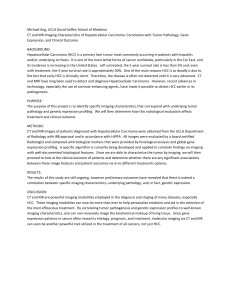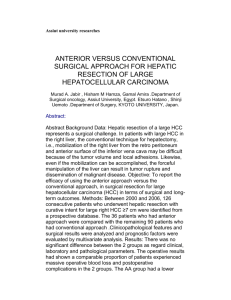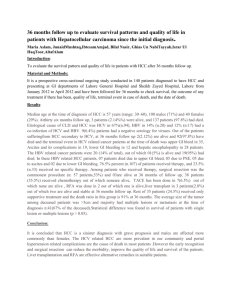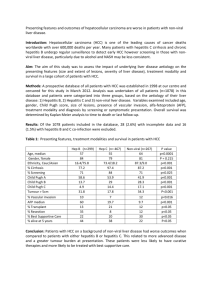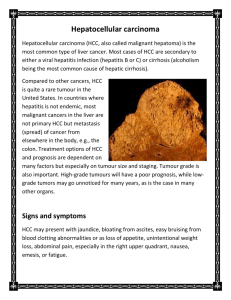APAMSA_Natl_Conf_Poster_Session_Abstracts
advertisement
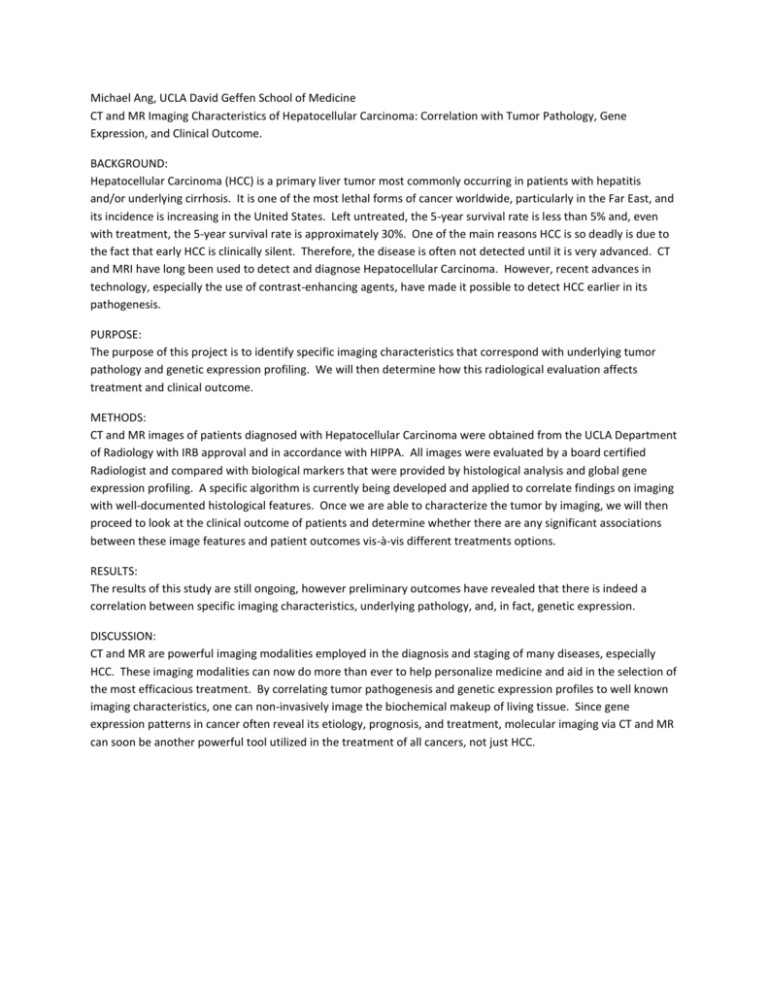
Michael Ang, UCLA David Geffen School of Medicine CT and MR Imaging Characteristics of Hepatocellular Carcinoma: Correlation with Tumor Pathology, Gene Expression, and Clinical Outcome. BACKGROUND: Hepatocellular Carcinoma (HCC) is a primary liver tumor most commonly occurring in patients with hepatitis and/or underlying cirrhosis. It is one of the most lethal forms of cancer worldwide, particularly in the Far East, and its incidence is increasing in the United States. Left untreated, the 5-year survival rate is less than 5% and, even with treatment, the 5-year survival rate is approximately 30%. One of the main reasons HCC is so deadly is due to the fact that early HCC is clinically silent. Therefore, the disease is often not detected until it is very advanced. CT and MRI have long been used to detect and diagnose Hepatocellular Carcinoma. However, recent advances in technology, especially the use of contrast-enhancing agents, have made it possible to detect HCC earlier in its pathogenesis. PURPOSE: The purpose of this project is to identify specific imaging characteristics that correspond with underlying tumor pathology and genetic expression profiling. We will then determine how this radiological evaluation affects treatment and clinical outcome. METHODS: CT and MR images of patients diagnosed with Hepatocellular Carcinoma were obtained from the UCLA Department of Radiology with IRB approval and in accordance with HIPPA. All images were evaluated by a board certified Radiologist and compared with biological markers that were provided by histological analysis and global gene expression profiling. A specific algorithm is currently being developed and applied to correlate findings on imaging with well-documented histological features. Once we are able to characterize the tumor by imaging, we will then proceed to look at the clinical outcome of patients and determine whether there are any significant associations between these image features and patient outcomes vis-à-vis different treatments options. RESULTS: The results of this study are still ongoing, however preliminary outcomes have revealed that there is indeed a correlation between specific imaging characteristics, underlying pathology, and, in fact, genetic expression. DISCUSSION: CT and MR are powerful imaging modalities employed in the diagnosis and staging of many diseases, especially HCC. These imaging modalities can now do more than ever to help personalize medicine and aid in the selection of the most efficacious treatment. By correlating tumor pathogenesis and genetic expression profiles to well known imaging characteristics, one can non-invasively image the biochemical makeup of living tissue. Since gene expression patterns in cancer often reveal its etiology, prognosis, and treatment, molecular imaging via CT and MR can soon be another powerful tool utilized in the treatment of all cancers, not just HCC. Kwan Hon Vincent Lau, Mount Sinai School of Medicine A Multi-Institutional Retrospective Study of Radiation Therapy in Patients with Oligometastases BACKGROUND: Although cancer that has progressed to metastasis is generally treated with palliative chemotherapy, recent evidence suggests benefit in high-dose image-guided radiation therapy for metastatic disease limited to five or fewer sites, a state termed oligometastasis. Two studies, conducted at Mount Sinai School of Medicine and Rochester Medical Center, have validated this method. To date, there lacks clear data identifying specific disease and treatment parameters correlating to greatest clinical benefit. OBJECTIVE: The purpose of this study was to identify disease and treatment characteristics which serve as prognostic factors for treating oligometastasis. METHODS: We merged the datasets from the two studies above (n = 165), and evaluated thirty-five independent patient, disease and treatment parameters against four outcome factors using multivariate analysis. RESULTS: Patients with breast cancer had statistically significantly better overall survival (OS), progression-free survival (PFS), local control (LC) and distant control (DC) (p = 0.007, p = 0.011, p = 0.000, p = 0.033 respectively), while those with head and neck cancers had worse OS and PFS (p = 0.002, p = 0.001). Patients with bone metastases had significantly better OS and PFS (p = 0.004, p = 0.008), while those with adrenal metastases had worse OS (p = 0.002). Patients with primary tumors with sarcoma histology had worse PFS and DF (p = 0.021, p = 0.014). Higher total dose for primary site radiation corresponded with better PFS and LF (p = 0.007, p = 0.000). CONCLUSION: Patients with specific disease and treatment characteristics, especially those with breast cancers or bone metastases who had received high doses of radiation for their primary tumor, may benefit most from radiation for oligometastatic disease. These patient groups can be identified and treated for their metastatic lesions before further disease progression. The prognostic factors identified may be validated in future prospective trials. Hillary Lin, Stanford University School of Medicine Southeast Asian Ethnicity a Predictor for Hepatitis C-Associated Hepatocellular Carcinoma Objective: The incidence of hepatocellular carcinoma (HCC) is growing in the U.S. due to increasing rates of hepatitis B (HBV) and C (HCV). Increased immigration from Asian countries with endemic viral hepatitis is a major cause of this phenomenon. Our goal was to identify and compare the etiologies of HCC in different Asian American sub-ethnic groups. Methods: We performed a cross-sectional retrospective study on 510 Asians diagnosed with HCC at a universityaffiliated liver clinic in the United States between November 1992 and December 2009. Comparisons were made among Southeast Asian (n = 270), Chinese (n = 206), and Korean (n = 36). Results: The Chinese cohort had the highest percentage of HBV-associated HCC, followed by the Korean and Southeast Asian cohort (78.4% vs. 61.1% vs. 47.4%, P < 0.0001). HCV-associated HCC was significantly higher among the Southeast Asian cohort compared to the Korean and Chinese cohorts (37.8% vs. 27.8% vs. 13.7%, P < 0.0001). There was no significant difference in the rates of HBV and HCV co-infection (3.9%). The Korean cohort had a significantly higher rated of cirrhosis compared to the Southeast Asian and Chinese cohort (77.8% vs. 66.3% vs. 52.0%, P <0.0001). Furthermore, prevalence rates of hemochromatosis- and cryptogenic-associated HCC were not significantly different (0.4% and 2.4%, respectively). Conclusions: Chinese patients have a much higher percentage of HCC associated with HBV rather than HCV (78.4% vs. 13.7%). Korean patients also have a strong majority of HBV-associated HCC cases (61.1% vs. 27.8% HCVassociated cases). However, Southeast Asian patients have an even distribution of HBV- and HCV-associated cases (47.4% vs. 37.8%). These statistics may be useful in identifying at-risk individuals for HCC screening. Philip Song, Johns Hopkins University School of Medicine The Clinical Profile of Merkel Cell Carcinoma in Mainland China Background Little is known about the presence or characteristics of Merkel cell carcinoma (MCC) inmainland China. Objective To describe the clinical profile of MCC in China. Methods At 18 cancer hospitals in metropolitan centers from the six geographical regions of mainland China, approximately 3,100,000 pathology database and medical records were reviewed for eligibility criteria of having a pathological diagnosis of MCC between 1970 and 2009. A case series was compiled from retrospective chart reviews of identified MCC patients. Results Eight out of 18 participating hospitals reported at least one record of a patient with a pathological diagnosis of MCC, and a total of 22 cases were identified. The median age of patients was 65.5, and 59% were female. The median time from the appearance of a lesion to the time of biopsy was 6 months, and the most common location of lesions was the head and neck. The most common treatment used was surgery alone. Conclusions MCC appears to be uncommon in mainland China. Patients in this series are elderly, often had lesions on the head/neck region, and most commonly received surgery alone as treatment. In contrast with MCC in Western countries, the current series’ patients were all of Asian ethnicity, had larger lesions at presentation, and none were documented as having HIV or other forms of immunosuppression. Michele YunZu Wang, Washington University School of Medicine in St. Louis Trends in utilization and donor attrition at the Singapore Bone Marrow Donor Programme Trends in utilization and donor attrition at the Singapore Bone Marrow Donor Programme Introduction: Growing bone marrow donor registries, developments in the use of cord blood stem cell utilization, and increasing collaboration between donor registries have contributed to an increase in hematopoietic stem cell (HSC) transplants performed worldwide in the last decade. Rates of growth and attrition from bone marrow donor registries in the U.S. and Europe have both been clearly documented, but there is not yet any published data for Asia. A more family-centered orientation and traditional superstitions may play a larger role in an Asian’s decision to donate HSCs. The purpose of this first study of HSC donor trends in Singapore is to analyze the impact of these changes and explore the reasons behind donor attrition in a pan-Asian context. Methods: Data from 1999-2009 was obtained from donor search files and other records at the Bone Marrow Donor Programme (BMDP) and the Singapore Cord Blood Bank (SCBB). Donor recruitment and donor attrition rates by racial groups were compared by chi-square analysis. Results: The BMDP and SCBB have been recruiting approximately 3,800 additional bone marrow donors and cord blood units annually, with a significant (χ2 = 2657) overrepresentation of ethnic Chinese donors in the BMDP. There has been nearly threefold growth in the number of HSC procurements for BMDP patients from 2005-2009 alone. Of the 126 potential donors registered through BMDP that were contacted between 2004 and 2009 57 refused to donate, of which 29% did so due to family objections. Conclusions: Overall, the current status of hematopoietic stem cell transplants in Singapore is healthy. Strategies to improve minority recruitment appear to be effective. By addressing preconceptions early and involving family from the beginning of the recruitment process, we seek to reduce BMDP donor attrition. We also hope that the findings of this study extend beyond Singapore to benefit other registries with Asian donors that are also confronting the problem of donor attrition, specifically for family reasons. Brandon Yim, Northwestern University Feinberg School of Medicine In vitro evaluation of the effects of a Malaysian herb, Vernonia amygdalina, on MCF-7 human breast cancer cells Abstract: In Malaysian traditional and folkloric medicine, a particular herb, Vernonia amygdalina (VA), commonly known as “bitter leaf”, is used for various therapeutic and nutritional purposes. The aim of this study was to assess leaf extracts of VA for anti-cancer properties and to determine the mechanism(s) by which it causes cancer cell death. In this study, MCF-7 human breast adenocarcinoma cells were treated with different doses of VA leaf extract for 48 and 72 hours, and subjected to the MTT cell viability assay. Additionally, cell cycle and cell discrimination analysis was conducted on VA-treated cells, using the flow cytometer. Data generated from the MTT assay indicated IC50 values for the 48- and 72-hour incubation periods of 110 μg/ml and 83 μg/ml, respectively. Dose-response curves indicated that the VA extract had a dose-dependent inhibitory action on the growth of MCF7 breast adenocarcinoma cells. Results from cell cycle analysis showed an accumulation of cells in the sub-G1 phase after VA treatment, suggesting apoptotic cell death. Results from cell discrimination analysis also suggested cell death by apoptosis. More detailed studies need to be done to determine the molecular targets of VA on the apoptotic pathway. In conclusion, VA leaf extract induced a dose-dependent apoptotic effect on MCF-7 breast adenocarcinoma cells. These very preliminary findings raise the possibility that VA may contain active compound(s) with the potential for development into a drug(s) for the treatment of human breast cancer. Li Zhou, Vanderbilt Medical School Effect of DMH1 on the Differentiation of mouse ES and iPS Cells DMH1 is a selective small molecule inhibitor of the BMP pathway that was discovered in our lab. As an essential component in the differentiation of embryos, the modulation of levels of BMP4 can commit stem cells to different lineages. It has previously been shown that treatment of CGR8 mouse ES (mES) cells with dorsomorphin, a relatively non-selective BMP4 inhibitor, increases the number of ES cells that differentiate into beating cardiomyoctes by 20-fold1. We investigated the effect of DMH1 on both mES and H11 mouse iPS (mIPS) cells for two reasons. The first was to test the efficacy of DMH1 on differentiating mES cells into cardiomyoctes. The second was to compare the intrinsic characteristics of mES and mIPS, cells to see whether they respond similarly to the same treatments. Our results show that >90% of our mES samples differentiated into spontaneously beating cardiomyocytes when treated with DMH1. However, the protocol applied to miPS cells revealed ~4% spontaneous cardiomyocytes when a identical protocol was applied. These results show that DMH1 is effective at committing mES cells to a cardiomyocte lineage. Furthermore, our results suggest an intrinsic difference between mES and mIPS cells in their ability to respond to BMP4 inhibitors, though other cell lines must be tested in order to strengthen this hypothesis.
